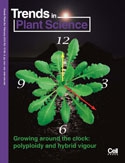
Polyploidy, also known as whole genome duplication, refers to a cell or organism that contains more than two basic sets of chromosomes. Polyploidy can be divided into autopolyplody, allopolyploidy, and paleopolyploidy. An allopolyploid such as wheat or African clawed frog is formed by hybridizing with two or more species followed by chromosome doubling, whereas an autopolyploid such as potato or salmon results from genome duplication within the same species. Many organisms that behave as diploid are actually paleopolyploid (ancient polyploid) and over time become diploidized, as shown in the sequenced genomes of yeast, Arabidopsis poplar tree, grapevine, maize, and soybean. Of flowering plants, over 70% may be recent polyploids, of which >75% are allopolyploids. Allopolyploids in Tragopogon,Spartina and Senecio have been recently formed in natural conditions. For example, Tragopogon(sunflower family) is native to Eurasia; allopolyploids were formed in 1900’s in North America and become invasive weeds in local environments. The common occurrence of polyploidy suggests an advantage of having additional raw genetic material for evolution and adaptation. Some traits, such as flowering time, apomixis, larger organs, stress tolerance, and growth vigor may allow them to enter new niches or improve fitness through natural selection and/or human domestication. Indeed, polyploids survive better than their parents in harsh environments, such as cold climates and high altitudes and latitudes. This may explain why many crops, including wheat, oat, cotton, canola, potato, sugarcane, switchgrass, coffee, banana, and strawberry are of polyploid origin.
Polyploidy is generally rare in mammals probably because sex chromosomes and imprinting genes in mammals are sensitive to dosage regulation. Polyspermy occurs in 2-3% of human conceptions that are abortive during pregnancy. Many cancer cells are polyploids and aneuploids. Although the cause and effect is unknown, the understanding of genomic and expression plasticity in plant polyploids may help us understand and ultimately control the growth of cancer cells. Polyploids are common in insects, fish and amphibians, and hybrids such as mule also occur in mammals. Estimates indicate that ~10% of animal and ~25% of plant species hybridize with at least one other species.
Origin of polyploidy
Two models for the origin of allopolyploids have been proposed. The “one-step” model suggests that an allotetraploid is formed by fusion of unreduced male and female gametes from two diploid species or by direct hybridization between two autotetraploid species, because almost every plant species produces a variable but small amount of unreduced gametes and many plant species are autotetraploids. The “two-step” model proposes that an allotetraploid is formed through hybridization between two diploid species followed by chromosome doubling of the F1 hybrid. The “two-step” process, usually using mitotic inhibitors such as colchicine, has been used to produce artificial allopolyploids such as in Brassica and wheat.
Autopolyploidy
Duplication of a single genome. Examples include potato, alfalfa, banana, and watermelon.
Allopolyploidy
Combination of two or more evolutionarily-divergent genomes. Examples include canola (Brassica napus), cotton, and wheat.
Paleopolyploidy
Ancient genome duplication that is diploidized. Examples include maize, cabbage, and Arabidopsis thaliana.
The distinction between auto- and allopolyploidy may not be very clear in some polyploids. Sugarcane is an extreme example. The modern sugarcane (Saccharum spp.) contains ~120 chromosomes with 70 to 80% of chromosomes derived from Saccharum officinarum, 10 to 20% fromSaccharum spontaneum, and a few chromosomes derived from interspecific recombination.
We are interested in understanding the genetic and epigenetic mechanisms for gene expression changes in Arabidopsis allopolyploids. Arabidopsis suecica is a natural allotetraploid that was formed ~12-300 thousand years ago between extant species of Arabidopsis thaliana and Arabidopsis arenosa. These two species diverged ~6 million years ago, a genetic distance similar to human and chimpanzee. Neo-allotetraploids can be readily synthesized by pollinating A. thaliana autotetraploid with A. arenosa (an outcrossing tetraploid) pollen. We hypothesize that plants use DNA sequence-independent or epigenetic mechanisms to regulate the expression of homoeologous genes following polyploidization. Using genetic, genomic, biochemical, and computational approaches, we are investigating how many genes, and by which mechanisms these genes are regulated during polyploid formation and evolution. [1-10]
Related web information about polyploidy
Polyploidy portal
Polyploidy Wikipedia
Ten selected reviews about polyploidy
- Chen ZJ: Genetic and epigenetic mechanisms for gene expression and phenotypic variation in plant polyploids. Annu Rev Plant Biol 58: 377-406 (2007)
- Comai L: The advantages and disadvantages of being polyploid. Nature Reviews Genetics 6: 836-846 (2005).
- Doyle JJ, Flagel LE, Paterson AH, Rapp RA, Soltis DE, Soltis PS, Wendel JF: Evolutionary genetics of genome merger and doubling in plants. Annu Rev Genet 42: 443-61 (2008).
- Lackson S, Chen ZJ: Genomic and expression plasticity of polyploidy. Curr Opin Plant Biol 13: 153-9 (2010).
- Leitch AR, Leitch IJ: Genomic plasticity and the diversity of polyploid plants. Science 320: 481-3 (2008).
- Muller HJ: Why polyploidy is rarer in animals than in plants. Amer Nat 59: 346-353 (1925).
- Osborn TC, Pires JC, Birchler JA, Auger DL, Chen ZJ, Lee HS, Comai L, Madlung A, Doerge RW, Colot V, Martienssen RA: Understanding mechanisms of novel gene expression in polyploids. Trends Genet 19: 141-7. (2003).
- Otto SP: The evolutionary consequences of polyploidy. Cell 131: 452-62 (2007).
- Soltis PS, Soltis DE: The role of hybridization in plant speciation. Annu Rev Plant Biol 60: 561-88 (2009).
- Wendel JF: Genome evolution in polyploids. Plant Mol Biol 42: 225-49 (2000).



